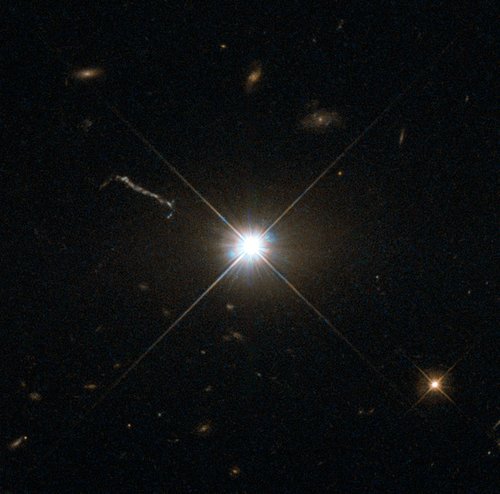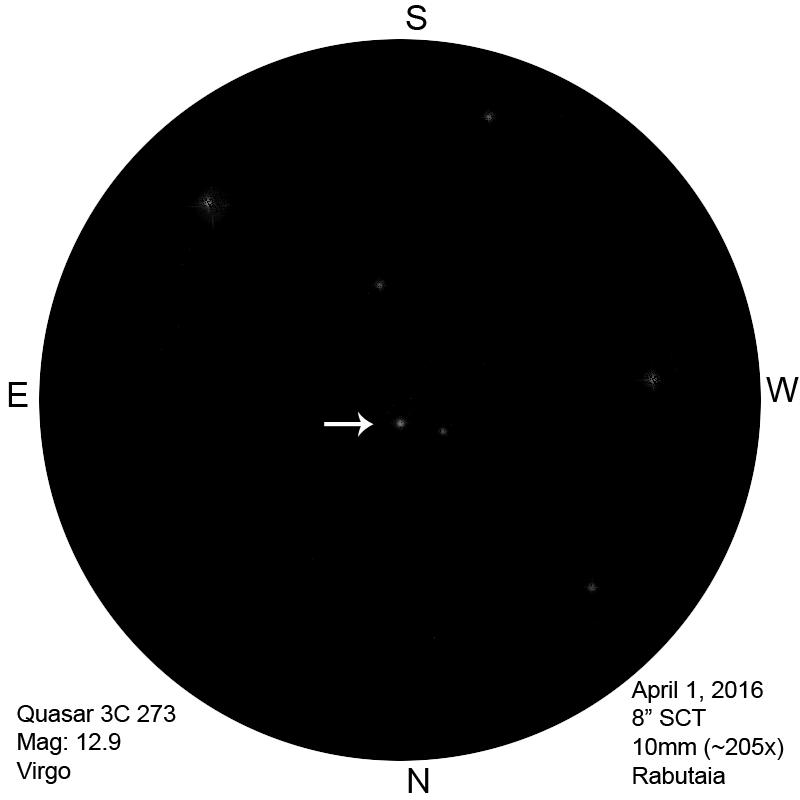Current Info for Observer
as of 04/19/2024 6:29 p.m.
Please login to view current observation details
General Info
| Type | Quasar |
| Constellation | Virgo |
| Right ascension | 12h29'0.670'' |
| Declination | +2°3'9'' |
| Magnitude | 12.900 |
| Catalog Designations | HIP6039 |
| Optically brightest quasar known | |
Generate a finder chart
The following form will generate a PDF finder chart suitable for printing using to locate objects in the sky with your telescope!
The Date is only really useful for solar system objects, as deep space objects move measurably only on a galactic timescale.
The larger the F.O.V (field of view), the more "zoomed out" the object will appear. It can be helpful to print several charts of the same object with different field of views.
Limiting the magnitude (remember, lower magnitude means brighter!) of stars and objects can make sure your chart is not cluttered with dim objects that you may not be visible to you anyway. The defaults are good, but try experimenting with raising and lowering the values.
Celestron C8 SCT
50 points
SKY: Limiting magnitude: 5.5 - 7 mile away, from a 300K-soul metropolis in the suburban outskirts (a mile or two more, and I'd be under 6.0 rural skies. Someday, who knows!)
MOTIVATION: It had been almost 5 years since I first observed the awe-inspiring (also, ancient) object that this quasar is. So, this is the third time only, as I honestly have no memory of how difficult (or easy) it was to find it then, from exactly in the same backyard. This time it definitely was simpler than what I actually arecall.
THE STEP-BY-STEP OBSERVATION: With the ever-lame 6x30 Celestron finder, I star-hopped from the Lambda Virginis pair, moving 3°24' north-by-northwest to 5.7-mag. FW Virginis, then already with a 32mm EP on the diagonal, I moved to the plough-like asterism whose brightest star is 12-magnitude HD 109521, then 25'W to the pair formed by HD 108978 and HD 108929 and finally SW to the right triangle whose east-southwestern vertex has the star BD +02 2547 as the brightest object and a 11.9-mag star at the southwest vertex, and a 12.6-mag. star for the northwest corner.
Already with a 10mm orthoscopic EP, (though a FL not very often used by me, it undeniably darkened the sky) I trace an imaginary straight line back to BD +02 2547, and could se a "loose pair" (as described it Craig Cortis on his may 2010 article on heskyscrapers.org) - 3C 273 is the brighetst (bluish?) of said pair.
Software used: Android's SkySafari Plus (only for this cases I miss the more complete SF pro version I had on my old iPhone.) so I had to complement that with said excellent Craig Cortis's article whose description made me to be certain what I was looking at.
Clicking on the sketch's image brings out an animated GIF with the stars' apparent magnitudes - which, by the way, was copied from my lame original one done by the scope, via a snapshot of the very same area on Google Sky; then Photoshoped to eliminate the field stars not actually visible with my instrument. I also used both Skysafari and skymaponline.net to name/magnitude-tag the other stars.
Please login to post comments

